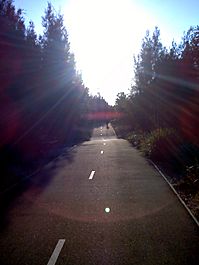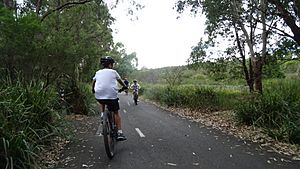Louise Sauvage Pathway facts for kids
Quick facts for kids Louise Sauvage Pathway |
|
|---|---|

Looking north towards ferry terminal
|
|
| Technical | |
| Line length | 6.3 km (3.9 mi) |
The Louise Sauvage Pathway is a special path in Sydney Olympic Park. It is named after Louise Sauvage, a famous Australian paralympic wheelchair racer. This pathway is the longest continuous path in the park. It's a great place for walking, riding bikes, and using wheelchairs. The pathway runs right next to the suburb of Newington, New South Wales.
Contents
What Can You Find on the Pathway?
The Louise Sauvage Pathway is designed for everyone to enjoy. It has two lanes and is clearly marked. This makes it easy to follow. Along the way, you might find smaller paths that branch off. Some of these are also paved, while others are unpaved.
The main pathway is only interrupted in two spots. These are where roads cross into Newington. This area used to be the athletes' village during the Sydney Olympics. For people using the path, there are useful things like five water fountains. There is also a toilet facility for visitors.
A Journey Through History
The pathway connects the Parramatta River in the north to the Western Motorway in the south. As you travel along it, you'll pass some interesting historical sites. One special spot is the last piece of untouched woodland in Sydney's Cumberland basin. This forest has been here for a very long time.
The pathway also gives you access to the Newington Armory. This used to be a place where weapons were stored. You'll even pass by some land that is closed to the public. This is because there might still be old, unexploded items buried there from when it was an armory.
Two old buildings from the Newington Arms Depot are now outside the main Armory grounds. You can see them from the pathway. One is Building 46, which is now used for education by Ausgrid. The other is an old US Navy artillery bunker. These bunkers were used to store dangerous explosive shells. There were even narrow railway tracks to move the shells around. You can still see many of these old tracks today, and some are open to explore from the pathway.
Nature and Wildlife Along the Path
The Louise Sauvage Pathway is surrounded by beautiful waterways and wetlands. Some of these water bodies, like Haslams Creek, flow into the Parramatta River. Other areas, such as the Narawang Wetlands, are artificial lakes. These lakes were created to help nature come back to Sydney Olympic Park.
There's a special side path called the Bell Frog Boardwalk. This boardwalk lets you get close to the rare habitat of the Green and Golden Bell Frog. These frogs are very special, and this area helps protect them.
The Newington Nature Reserve is also nearby. It contains a Turpentine Ironbark Margin Forest. This forest is very old and looks just like it did before Sydney was settled. It's a great example of Australia's natural environment.
Fun Events and Activities
Every September, the Louise Sauvage Pathway closes for one day. This is for long-distance cyclists who are riding through Olympic Park. The pathway is a key part of big cycling events, like the Sydney Spring Cycle (Classic Route).
For people who like to ride their bikes across the city, the pathway is often part of popular routes. Many riders use a combination of the Silverwater Road Bridge, the River Walk, and the Louise Sauvage Pathway. These routes can take you from the Hills District to southern suburbs like Liverpool. You can also ride from Parramatta to inner-western suburbs or even to Sydney Airport using the Cooks River cycleway.


